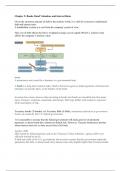Chapter 5: Bonds, Bond Valuation, and Interest Rates
Given the enormous amount of debt in the modern world, it is vital for everyone to understand
debt and interest rates.
A bondholder’s return is a cost from the company’s point of view.
This cost of debt affects the firm’s weighted average cost of capital (WACC), which in turn
affects the company’s intrinsic value.
bond
A promissory note issued by a business or a governmental unit.
A bond is a long-term contract under which a borrower agrees to make payments of interest and
principal, on specific dates, to the holders of the bond.
Investors have many choices when investing in bonds, but bonds are classified into four main
types: Treasury, corporate, municipal, and foreign. Each type differs with respect to expected
return and degree of risk.
Treasury bonds (T-bonds) and Treasury bills (T-bills), sometimes referred to as government
bonds, are issued by the U.S. federal government.
It is reasonable to assume that the federal government will make good on its promised
payments, so these bonds have almost no default risk. However, Treasury bond prices decline
when interest rates rise, so they are not free of all risks.
Agency debt
Debt issued by federal agencies such as the Tennessee Value Authority. Agency debt is not
officially backed by the fu
ll faith and credit of the U.S. government, but investors assume that the government implicitly
guarantees this debt, so these bonds carry interest rates only slightly higher than Treasury bonds.
, GSE debt are not officially backed by the full faith and credit of the U.S. government, but
investors assume that the government implicitly guarantees this debt, so these bonds carry
interest rates only slightly higher than Treasury bonds.
Corporate bonds, as the name implies, are issued by corporations. Unlike Treasury bonds,
corporate bonds are exposed to default risk—if the issuing company gets into trouble, it may be
unable to make the promised interest and principal payments.
Municipal bonds, or “munis,” are issued by state and local governments. Like corporate bonds,
munis have default risk. However, munis offer one major advantage: The interest earned on most
municipal bonds is exempt from federal taxes and also from state taxes if the holder is a resident
of the issuing state. Consequently, municipal bonds carry interest rates that are considerably
lower than those on corporate bonds with the same default risk.
Foreign bonds are issued by foreign governments or foreign corporations. Foreign corporate
bonds are, of course, exposed to default risk, and so are some foreign government bonds
The par value is the stated face value of the bond; for illustrative purposes, we generally assume
a par value of $1,000. In practice, some bonds have par values that are multiples of $1,000 (for
example, $5,000), and some have par values of less than $1,000. (Treasury bonds can be
purchased in multiples of $100.) The par value generally represents the amount of money the
firm borrows and promises to repay on the maturity date.
MicroDrive’s bonds require the company to pay a fixed number of dollars of interest every year
(or, more typically, every 6 months). When this coupon payment, as it is called, is divided by
the par value, the result is the coupon interest rate. For example, MicroDrive’s bonds have a
$1,000 par value, and they pay $100 in interest each year. The bond’s coupon interest is $100, so
its coupon interest rate is 100/1000= 10%. The coupon payment, which is fixed at the time the
bond is issued, remains in force during the life of the bond.
In some cases, a bond’s coupon payment will vary over time. For these floating-rate bonds, the
coupon rate is set for, say, the initial 6-month period, after which it is adjusted every 6 months
based on some market rate. Some corporate issues are tied to the Treasury bond rate; other issues
are tied to other rates, such as LIBOR
Floating-rate debt is popular with investors who are worried about the risk of rising interest rates
because the interest paid on such bonds increases whenever market rates rise. This stabilizes the
market value of the debt, and it also provides institutional buyers, such as banks, with income
that is better geared to their own obligations.
Banks’ deposit costs rise with interest rates, so the income on floating-rate loans they have made
rises at the same time as their deposit costs rise. The savings and loan industry was almost
destroyed as a result of its former practice of making fixed-rate mortgage loans but borrowing on




